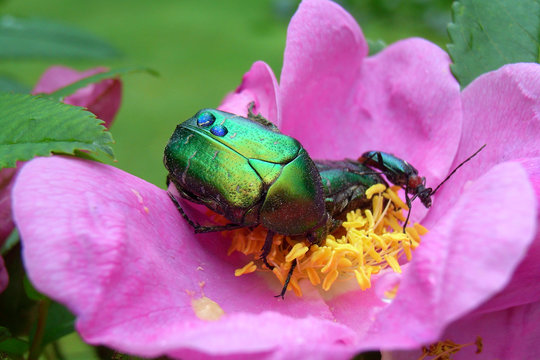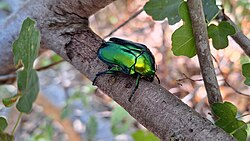Flower chafers are a striking group of beetles known for their vibrant metallic colors—often shimmering in shades of green, bronze, or black. These beetles are frequent visitors to flowers and fruits, making your garden their favorite hangout spot. While their dazzling appearance can be captivating, flower chafers sometimes cause damage by feeding on petals and fruits. Fortunately, with a little knowledge and care, you can manage their presence effectively and keep your garden thriving.
What Are Flower Chafers?
Flower chafers belong to the Scarabaeidae family and are commonly found buzzing around blossoms during the day. They play an important role in pollination but can occasionally become pests if their population grows unchecked. Understanding their behavior helps gardeners balance their presence without harming the ecosystem.
Spotting Flower Chafers in Your Garden
The easiest way to identify flower chafers is by their shiny, metallic bodies. Depending on the species, you might see beetles with iridescent green, bronze, or even black shells. They tend to be active during sunny days, often perched on flowers or fruit, feeding and resting.
Signs of Flower Chafer Activity
If you notice your flowers with nibbled petals, disrupted pollen, or fruits with bite marks, flower chafers could be the culprits. These beetles use their strong mandibles to chew on soft plant parts, which may sometimes affect the beauty and yield of your garden.
Gentle Ways to Control Flower Chafers
When the infestation is light, handpicking is an effective and eco-friendly method. Simply pick the beetles off gently and relocate them away from your plants. This hands-on approach avoids using harsh chemicals and keeps your garden safe for pollinators.
For larger populations, consider using mild, plant-safe treatments like insecticidal soap or neem oil sprays. These solutions help control beetle numbers without harming beneficial insects such as bees and ladybugs. Always apply sprays early in the morning or late in the evening to minimize impact on pollinators.
Encourage Natural Predators

One of the best ways to manage flower chafers naturally is by inviting their predators to your garden. Birds, frogs, and beneficial insects like ladybugs and lacewings love to feast on beetles. Providing habitats like birdhouses, water sources, and diverse plantings can attract these helpful creatures.
Keep Your Garden Clean and Inviting
Flower chafers are attracted to overripe fruits and fallen petals. Regularly cleaning up your garden by removing decaying plant matter reduces hiding spots and food sources for these beetles. A tidy garden discourages excessive flower chafer populations and promotes overall plant health.
Observe and Adjust Your Strategy
Gardens are unique ecosystems, and what works in one may differ in another. Keep an eye on the effectiveness of your control methods and be ready to adapt. Sometimes a combination of handpicking, natural predators, and mild sprays provides the best balance.
Why Care About Flower Chafers?
While flower chafers may cause some minor damage, they are also part of the natural balance. They contribute to pollination and serve as food for many other wildlife species. Managing them thoughtfully helps maintain a healthy and vibrant garden ecosystem.
Final Thoughts
Flower chafers bring a splash of color and life to your garden but require mindful management to prevent harm to your plants. By learning to identify them, monitoring their activity, and using gentle control methods, you can coexist peacefully with these fascinating beetles.
Remember, your garden is a living space filled with intricate relationships. Stay curious, respect nature’s balance, and your flowers will bloom beautifully for seasons to come!
🌼 Happy gardening, and may your garden flourish with life and color! 🌼


amoxicillin where to buy – https://combamoxi.com/ buy amoxil sale
order fluconazole 100mg pill – oral fluconazole 100mg oral fluconazole 200mg
order cenforce – buy generic cenforce online purchase cenforce online cheap
cheap cialis for sale – https://ciltadgn.com/# no presciption cialis
cialis side effects – which is better cialis or levitra cialis pills
sildenafil 50 – https://strongvpls.com/ viagra cheap canada
I am in truth happy to glitter at this blog posts which consists of tons of profitable facts, thanks for providing such data. https://buyfastonl.com/gabapentin.html
This website really has all of the information and facts I needed adjacent to this thesis and didn’t comprehend who to ask. https://gnolvade.com/es/comprar-finasterida/
I’ll certainly carry back to read more. https://ursxdol.com/sildenafil-50-mg-in/
More text pieces like this would make the интернет better. https://prohnrg.com/product/loratadine-10-mg-tablets/
Thanks an eye to sharing. It’s outstrip quality. aphrodisiaque cenforce
The thoroughness in this section is noteworthy. https://ondactone.com/spironolactone/
This is the kind of literature I truly appreciate.
https://doxycyclinege.com/pro/topiramate/
With thanks. Loads of erudition! http://www.predictive-datascience.com/forum/member.php?action=profile&uid=44943
forxiga 10 mg brand – https://janozin.com/ buy forxiga generic
buy cheap xenical – https://asacostat.com/# oral orlistat 60mg
More articles like this would pretence of the blogosphere richer. http://seafishzone.com/home.php?mod=space&uid=2330972
You can conserve yourself and your dearest close being cautious when buying panacea online. Some druggist’s websites control legally and provide convenience, solitariness, bring in savings and safeguards as a replacement for purchasing medicines. buy in TerbinaPharmacy https://terbinafines.com/product/amantadine.html amantadine
This is a keynote which is virtually to my heart… Myriad thanks! Quite where can I notice the acquaintance details for questions? prednisolone 20 mg posologie adulte
More posts like this would prosper the blogosphere more useful.